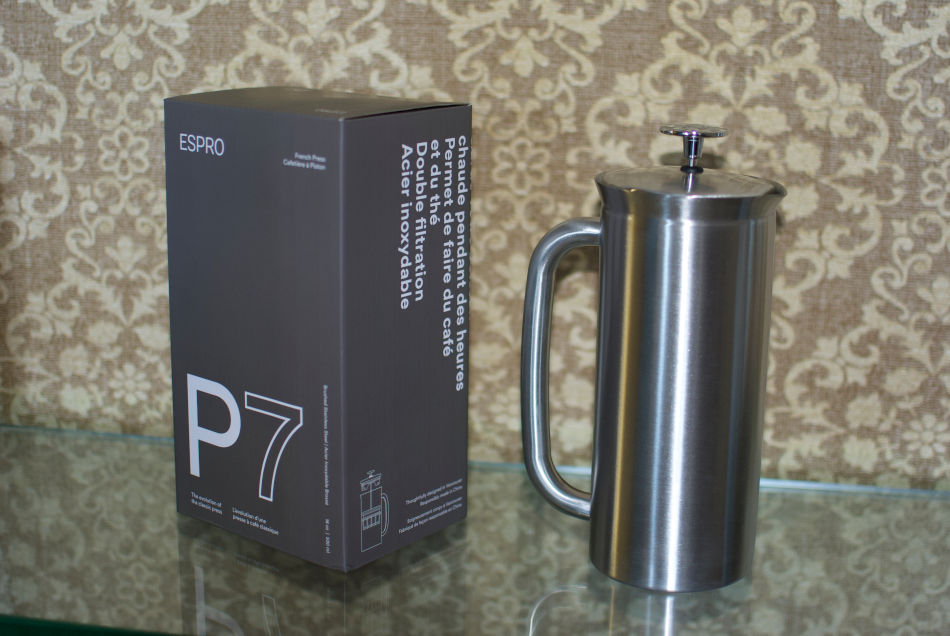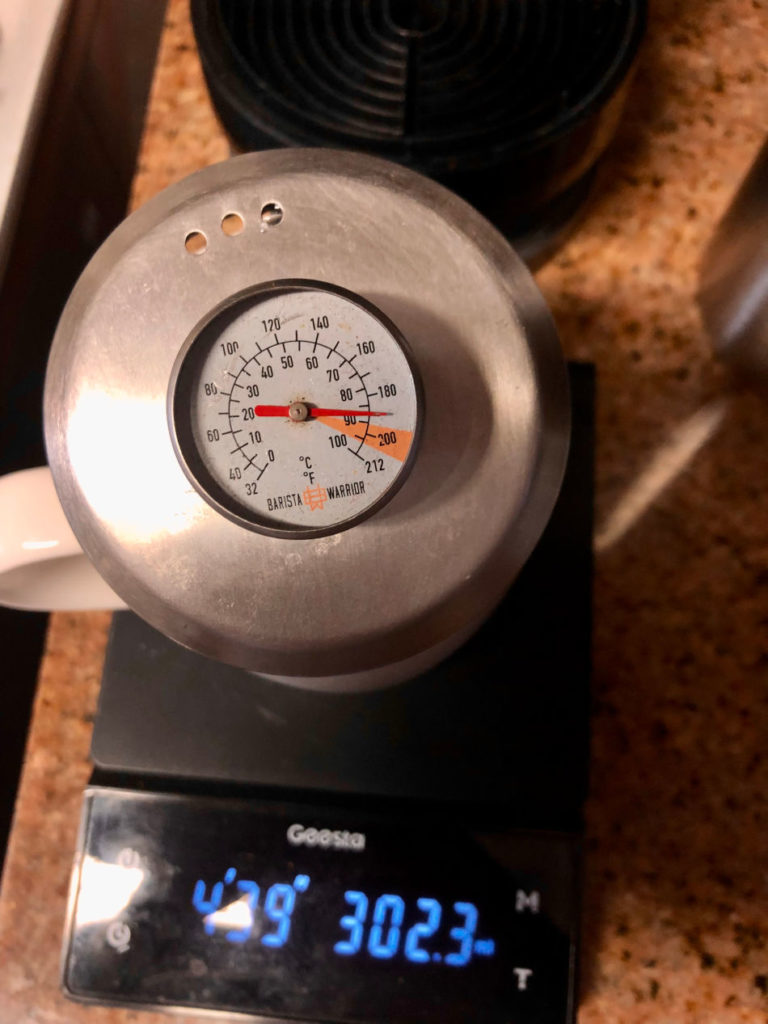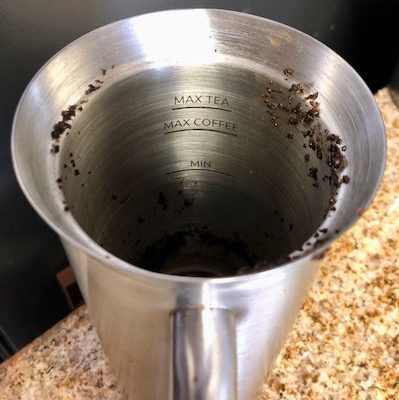This is an independent review of the ESPRO P7 French-Press. We purchased and used it on a regular basis to collect our data and document our experience.
ESPRO has been gaining market awareness, especially in the specialty coffee scene. In our search for the best tools to extract the best possible cup from our specialty coffee beans, we landed with this manufacturer and decided to give it a try.

Espro is a company devoted to elevating the coffee experience, by finding improvements opportunities for simple inventions that haven’t changed for quite some time. Their second approach was the French Press. They had 3 key elements they wanted to have that make a great cup of coffee:
- Temperature
- Extraction
- Filtration
With these 3 elements in mind, they started to explore ways to improve the French press.
What is the ESPRO P7 French Press?
ESPRO P7 French Press is a coffee maker from the immersion brewing method, where coffee grounds are manually immersed into water to extract the flavor from the beans. ESPRO developed a double micro-filter method allowing two-stage filtering, resulting in a cleaner cup with less grit than the average single filter french press.
In our experience, the key difference between standard or average French Press is evident compared to an ESPRO. The filter is the most important part of the device since is the one responsible for separating the grounds from the liquid.
Personally, I’m not a fan of a cup containing grounds in the bottom, so if there is a French Press that will produce a clean cup, I’m all in!
What makes an ESPRO P7 French Press different?
ESPRO P7 has the following claims:
- Insulated stainless steel will maintain your drink temperature
- Two Filters trap all the grit and sludge for ultra-smooth coffee
- Seal to Separate filtered from unfiltered coffee
Does ESPRO P7 holds temperature?
Based on the initial objectives of the engineers at Espro, one of the claims we found from the P7 is that you can leave the brewed coffee in the press after you finish your brew because the P7 has double-wall insulation, which should maintain temperature better than glass, which is the most popular material for French press.
To validate this claim, we decided to conduct a test with only two variables: Time and Temperature. We started the clock when we started to pour the hot water into our ESPRO P7 french press. We capture the temperature as follows
| Time | Temperature |
| 0 minutes – Prior to brew | 200º F |
| 4 minutes – brew completion | 190º F |
| 5 minutes | 180º F |
| 6 minutes | 175º F |
| 7 minutes | 170º F |
| 8 minutes | 170º F |
| 9 minutes | 165º F |
| 14 minutes – (10 minutes after the brew) | 160º F |
At the 4-minute mark, we served 1 cup and left around 6 ounces of brewed coffee inside the ESPRO P7. Every minute we did a small sample and measured that temperature. Ten (10) minutes after the initial serving, we evidenced a 160º F for the lastly served coffee.

On average, the coffee brewed and kept inside the ESPRO P7 shall maintain a suitable temperature of 160º F (71º C) for drinking coffee up to 15 minutes after starting the brew. The insulated stainless-steel technology allows you to maintain temperature throughout the brewing as long as you keep the lid in place.
From the temperature perspective, ESPRO P7 has a better temperature performance compared to the average glass French press that will lose heat as time goes by.
Can I leave coffee in the ESPRO P7 after brewing?
Aside from retaining temperature after the brewing process, ESPRO P7 claims to separate the brewed coffee from the ground coffee, this way you can leave your coffee within the French Press without risking the coffee quality by over-extracting due to an extended exposure of the water to the beans.
ESPRO Coffee French Press P7 has a silicone seal around the patented double micro-mesh filter that separates the grounds and grit from brewed coffee at the top. This prevents bitter flavors from over-extracted coffee that has been exposed to the grounds longer than necessary to mix with the filtered brewed coffee.
If you spent the extra dollars to get an ESPRO P7, aside from quality beverages, you might also want to leave your press in the middle of the table so you, and your coffee companions, can admire the good-looking device.
What temperature does ESPRO P7 brew coffee?
The initial temperature to brew your coffee on a French Press shall be 195º F to 205º F. Depending on the materials of the Jar and the time you decide to brew, you should start to lose temperature as time goes by.
On average, the ESPRO P7 shall produce a cup of coffee at 190º F after a 4-minute brew. This is thanks to their double-wall insulation that helps keep the temperature inside the jar during and after the brew. Experts recommend pouring water between 195º F and 205º F for a French Press.
Having an insulation system allows the French Press to maintain a more stable temperature during the brew, allowing the extraction to be more efficient resulting in a better cup of coffee.
How much coffee can I make with ESPRO P7?
ESPRO P7 French Press comes in two sizes: 18 oz (532 ml) or 32 oz (946 ml).
Using the 18oz, there is a minimum batch of 2 ounces of ground coffee (56 grams) + 18 oz of hot water.
On the upper side, you can only brew up to 22 ounces (591 ml) of coffee.
The same will happen with the 32oz, where the minimum is 32 oz of liquid plus ground coffee, and it can brew up to 40 oz of coffee + ground.
We don’t recommend the 32 oz version for a small coffee group.
It is very important to mention that there is a minimum brew size in order for the press to work properly. It will be very difficult to brew a single cup (6 oz | 177 ml), because the plunge is not designed to go all the way to the bottom. That being said, if you only need 6 oz of coffee, this shouldn’t serve your purpose.

Is the ESPRO P7 dishwasher safe?
Depending on the brewer you use on a regular basis, you will be familiar with the coffee aftermath: Cleaning. Cleaning your ESPRO P7 could be time-consuming because of the double filter that you need to take apart. Fortunately, the ESPRO P7 Coffee French Press is top-rack dishwasher safe. So that takes 1 step out of the equation.
The suggested method to clean the micro-filters is to use the ESPRO Cleaning Powder. It helps to remove all coffee, tea, and milk solids (if any) within the filters.
Can I use a paper filter with the ESPRO P7?
ESPERO has a paper filter that you can insert between the two micro-filters to create an ultra-clean, oil-free coffee cup. Some may not agree with this approach, because the French Press is known to be a full-bodied cup including coffee oils. But at the end of the day, this provides more versatility to the device to be enticing for a broader audience.
Want to give it a try? Espro.com and Amazon.com.
Where are ESPRO Coffee French Press P7 made?
ESPRO P7 was designed in Ontario and is manufactured in China.
Does ESPRO P7 worth the price?
I see the ESPRO P7 as a niche coffee brewer, on the upper end of the spectrum, to be considered a premium or even luxury. If you are concerned about the elements that actually distance the ESPRO P7 from the average French press, I’d say it is worth the price.
Same as this site, I’m all about specialty coffee. I want equipment that will get the best out of my 90+ coffees. ESPRO P7 allows me to get coffee oils with reduced grounds, or sludge. That, for me, it’s worth every penny. I expect my ESPRO P7 to last several years, that is why I decided on the stainless steel. Durability has a price.
If you want to try it by yourself, you can ESPRO P7 on Espro.com, or on Amazon.
If you only going to brew commercial coffee and don’t mind coffee grounds being present in your cup, then you will be best served with a $30-$50 alternatives.
Conclusions
I really enjoy my cup of coffee brewed on my ESPRO P7, it provides versatility to conduct my tests, and also a reliable brew when needed. Since some of my peers don’t like the grounds at the bottom of the cup, I eventually use the paper filter to get a clean cup.
If you want a premium and durable French Press, ESPRO P7 is a great option.
Pros:
- The temperature claim is on point, it really keeps a good temperature for coffee drinks.
- The filtering reduces grounds and sludge going into your cup.
- The material feels very resistant stainless steel
Cons:
- Cleaning is more demanding than other alternatives due to the double filtering.
- You can’t brew only 1 cup.